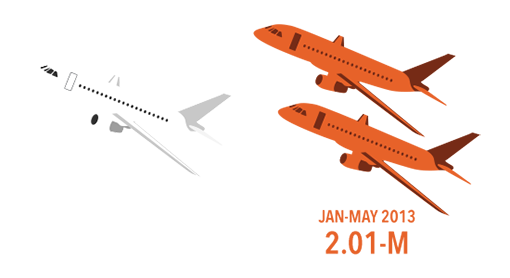Aquino's economy: A snapshot
- Indicators Then Now
- GDP 7.3% 7.8%
- Poverty 28.6% 27.9%
- Jobs 35.4-M 37.819-M
- Underemployed & Unemployed 9.395-M 10.338-M
- Inflation 3.9% 2.9%
- Budget Deficit P162.107-B P42.839-B
- Revenue Collections P500-B P708.374-B
- Debt per Filipino P51,095 P57,063
- PSE Index 4,201.14 6,619.95
- Exports 42.1% -6.18%
- Foreign Tourist Arrivals 1.307-M 2.01-M
- FDI $779-M $1.577-B
- Forex P45.1097:$1 P41.56611:$1

Defying economists' expectations, the Philippine economy grew 7.8% in the first quarter of 2013, the fastest since President Benigno Aquino III took office. The figure was much higher than the government's 6%-7% target -- also the goal for full-year 2013 -- and the 6.8% climb in 2012. The surprising first-quarter growth was driven largely by the robust expansion of the manufacturing and construction sectors. Strong household and government spending also helped.

Despite economic gains, the country's poverty incidence virtually stayed the same. Latest data from the National Statistical Coordination Board showed poverty incidence stood at 27.9% in January to June 2012, versus 28.6% and 28.8% in the same months of 2009 and 2006, respectively. NSCB releases poverty data every 3 years.

More jobs were created by the economy, however. Working Filipinos reached 37.819 million as of April 2013, higher than the 35.4 million recorded as of April 2010. Over two million people joined the labor force, which expanded to 40.9 million from 38.5 million.

The number of unemployed fell to 3.086 million as of April 2013 from 3.097 million as of the same period of 2010. But the underemployed or those seeking more jobs or longer working hours rose to 7.252 million from 6.298 million.

Inflation or the rise in consumer prices remained low and within the government's 3%-5% target from 2010 until middle of 2013. Low inflation encourages people and businesses to spend, boosting the economy.

Total revenue collections of the country's tax agencies continued to grow, but still fell below government targets. The Aquino administration vowed to plug the leakage in the tax system by going after tax cheats and smugglers. The Bureau of Internal Revenue, which accounts for most of revenue collections, launched an aggressive drive against corporations as well as self-employed and professionals who are evading taxes.

The Aquino administration was able to trim its budget deficit even amid efforts to accelerate spending. The Philippines' low deficit helped it win investment grade status for the first time ever in 2013.

Debt is what government uses to plug the gap between its revenue collections and spending. Government debt continued to rise in the last few years, although at a slower pace during Aquino's term. Finance officials attributed this to debt management efforts such as the lengthening of maturities of loans and foreign loans' conversion into local currency. Changing the debt mix in favor of local debt protects the economy from risks related to volatility in the foreign exchange market.

The PSEi continued to hit new all-time highs in 2013, making it one of the best performing in the region. However, it touched, although just briefly, bear territory in June after the US Fed hinted it might reel in its stimulus program on signs the US economy was recovering well. The Fed announcement prompted investors to dump emerging markets including the Philippines. But analysts said strong economic fundamentals continue to buoy investor appetite for Philippine stocks.

Foreign direct investments (FDIs) in the country continued to grow on the back of favorable macroeconomic conditions, although they still lagged behind neighbors in the region. The government aims to attract more FDIs because they are sustainable and they create jobs and grow the economy.

Exports fell 6% in the first quarter of 2013, reversing their high 42% growth in the same quarter of 2010, as demand for the country's trading partners weakened. Electronic products account for most of the country's exports.

Foreign direct investment (FDI) inflows in the country continued to grow on the back of favorable macroeconomic conditions, although still lagged behind neighbors in the region. Unlike capital that flows into the stock market, which enters and exits easily, FDI is what the government aims to attract because it is sustainable and it create jobs and grow the economy.

Tourist arrivals continued to grow on the back of the success of the government's "It's More Fun in the Philippines" campaign as well as the increase in cheap flights. The Aquino government targets to attract 10 million foreign tourists by the end of its term. The tourism industry expects to get a boost from the recent lifting of the European Union ban on Philippine Airlines.

Portal 2 is an action shooter game from Valve Software that draws
from the original formula of innovative gameplay, story, and music,
which earned the original Portal more than 70 industry accolades.

The peso strengthened against the US dollar as investors put funds in local stocks and other emerging market assets. A stronger peso makes the country's imports cheap. However, it also hurts exporters and families of overseas Filipinos who earn money in dollars.